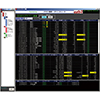Predictive Control
An approach to controlling equipment and systems on the basis of the predicted outcome, selecting the variables that will best control the equipment in order to achieve the target.
- Optimally controlling equipment based on prediction
- ICT development improves prediction accuracy, stimulating research into new areas of application

Optimally controlling equipment based on prediction
When operating equipment and systems, highly dependable control is required for safe and efficient operation. Automated control technology was developed as one such highly dependable method of reducing human work load. PID control,※1 for example, is a typical approach widely used to control the temperature of raw materials in the production process.
Predictive control is expected to further improve quality and productivity, reduce costs, and conserve energy. It refers, for example, to supply-and-demand-based production planning, considering what to produce and how much to produce in order to minimize waste. In another case, it simply refers to optimal control for highly efficient device operation. So long as devices or systems are controlled based on some kind of prediction, that type of control can be considered to be predictive control.
A typical application of predictive control is for managing building air conditioning. A variety of heat source equipment is used in buildings that use either gas or electricity as their energy source. Since air conditioning load varies depending on various factors as day-time high temperature, the number of visitors to the building, etc., the building is maintained best by predicting the demand for cooling or heating load at a given time and operating the heat source equipment based on the unit price of the different types of energy and the operational specifications of the equipment.
On the other hand, in process-related production facilities like petrochemical plants, a method called model predictive control has been used since around 1980. It determines the best control method by back-calculating the amount of control based on a computer simulation of what will happen in a certain amount of time, using the measured values to model how the state (temperature, pressure, flow rate, etc.) of raw materials like petroleum will change given the operating con ditions. Production facilities regularly use these calculations to achieve reliable operation and improved quality.
ICT development improves prediction accuracy, stimulating research into new areas of application
It is fair to say that the evolution of ICT※2 has an influence on the widening application of predictive control. As a result of the development of IoT※3-related technology capable of collecting values measured by devices via networks, we can now gather a variety of data and thus gain a detailed understanding of the object of control and the operating status of devices. At the same time, since we are now able to use advanced technology to analyze a large amount of such data, the accuracy of prediction has increased, and therefore the usability of predictive control has improved.
Research to apply predictive control to everyday life has already begun. For example, once traffic is congested, it takes quite a while for it to flow smoothly again. For that reason, there are now experiments that aim to prevent traffic jams by optimally controlling traffic signals based on past data. Also, research is proceeding to apply model predictive control to support systems for drivers and for more efficient train operation.
To achieve the vision of a smart city (eco-friendly city with efficient use of electricity and conservation of natural resources), accurate prediction of electricity supply and demand is considered to be the key to reliable control, especially for smart grids (next generation power grids), which allow for optimization of the electricity supply. It is anticipated that predictive control will be adopted in various fields as a tool to help increase energy savings.
※1: PID control is a type of feedback control whose mechanism employs a combination of three types of control action, namely proportional, integral, and derivative. ※2: ICT is an acronym for information and communication technology. It includes systems and services that allow users to use information by means of computers and networks. ※3: IoT is an acronym for the internet of things. It describes a mechanism in which things, such as tools and devices, are connected with each other (networked) either directly or indirectly. It is also understood to refer in a broad sense to systems designed to add value to products using this mechanism.



